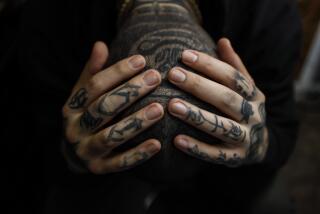Beijing’s Olympic Logo Runs Afoul of Taste, Chinese Protest
BEIJING — If you think the Chinese are afraid to express themselves, look online and see how they are blasting the new logo for the 2008 Summer Olympics.
“The figure looks so weak. The legs are soft and limp, like a eunuch trembling before his master,” one said recently on one of China’s largest Internet portals.
“It doesn’t represent China well,” another person said. “It looks like a hunched-over female servant. Or an old man wearing a No. 2008 hat running out of breath.”
“It’s a classic kneeling position,” a third writer punched out eight times, followed by 15 exclamation points.
But to the Chinese government that picked it and the International Olympic Committee that approved it, the design is an ingenious combination of Chinese culture and the Olympic spirit -- the Chinese character that means “capital” and puts the “jing” in Beijing, shaped to resemble a runner. It is imprinted against a red background in the style of a traditional ink seal, or chop.
Chinese officials call it “Chinese Chop, Dancing Beijing.” And they went all out to sell it in a nationally telecast ceremony early this month directed by acclaimed film director Zhang Yimou and featuring movie stars Jackie Chan and Gong Li.
“The logo uses the 5,000-year-old art of calligraphy and chop-making to cleverly depict an athlete racing toward victory. It represents the goodwill of 1.3 billion Chinese people -- it’s our gift to the Olympic movement,” said Liu Qi, Beijing Communist Party secretary and head of the Beijing Olympic committee.
It’s hard to find anything to please 1.3 billion taste buds these days. It’s even harder now that a growing number of Chinese citizens have access to information technology that connects them to the world around them.
Two days after the emblem’s debut, as many as 14,000 people flooded the popular Sina.com Web site with their opinions. Many simply hated the design. The complaints ran the gamut.
Some said it looks like a red glob that resembles a Japanese flag or a phallic-shaped thumbprint.
The more common vision was a beggar, a slave, a birdman, or a patient suffering a seizure, something that reminds them of the colonial-era insult that China was the “sick man of Asia.” That’s because, instead of seeing it as an athlete running toward the right, they see it as a bowing profile kowtowing to the left.
One person said that most people in the world do not recognize Chinese characters and that, without the benefit of explanation, they’d probably mistake the chop for a tombstone.
For Chinese outside the capital, the design is too Beijing-centered. One person suggested starting a petition of protest around the country, saying that Beijing does not represent all of China.
There are those who braved the avalanche of disgust to defend the figure.
“Some people will attack anything, as long as it’s made in China,” wrote someone who called himself Sharp Knive Class President.
“Opinions on the Internet are often biased toward extremes,” said Lu Benfu, a professor at the Chinese Academy of Social Sciences in Beijing who specializes in Chinese Internet research. “They don’t necessarily represent the mainstream view.”
But Lu said that he, too, found the symbol lacking: “It’s too Chinese, too closed up. It gives you a feeling of claustrophobia. Not the best choice in an era of globalization.”
Even those who like the design, by a Beijing-based company called AICI, say they wish there is more transparency to the selection process.
“The Olympics is a great event, we shouldn’t be overly critical,” said recent college graduate Zhang Fan. “But the bidding process was definitely not open enough. We didn’t know it existed. We only know the result.”
More to Read
Go beyond the scoreboard
Get the latest on L.A.'s teams in the daily Sports Report newsletter.
You may occasionally receive promotional content from the Los Angeles Times.






